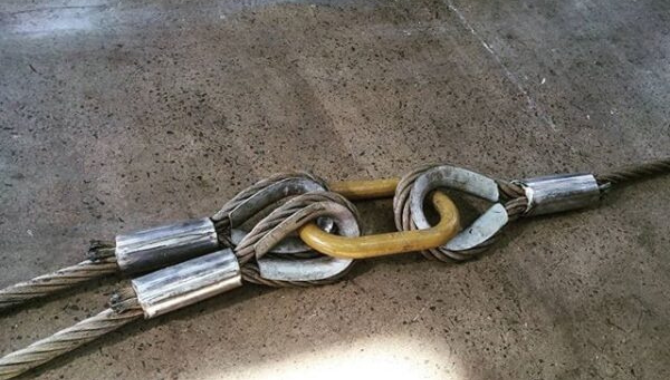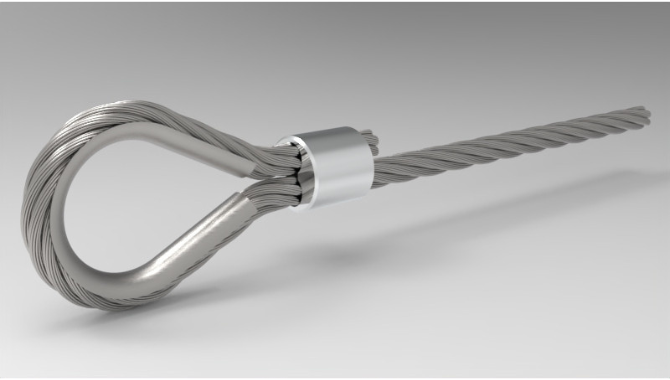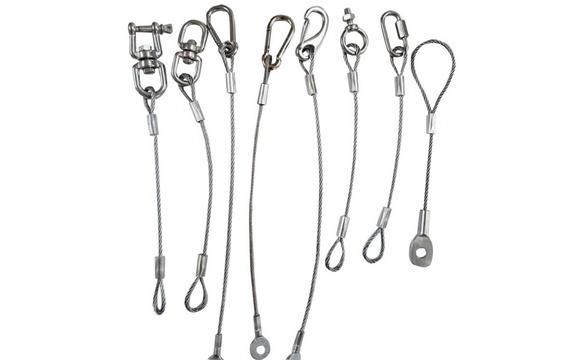Wire rope sling is a commonly used lifting and rigging equipment in various industries. It is made of multiple strands of steel wires twisted together to form a strong and flexible rope. Wire rope sling is designed to lift, lower, pull and secure heavy loads, and it is essential to understand its features, properties, and safe use to ensure proper and safe handling of loads.
In this essay, we will discuss everything you need to know about wire rope sling, including its construction, types, applications, maintenance, and safety measures.
Construction and Properties
Wire rope sling is made of individual steel wires twisted together to form a helical rope. The most commonly used type is the 6×19 class with six outer strands of 19 wires each. The outer wires are twisted around the inner core in a helical pattern to achieve high strength and flexibility. Other constructions, such as 6×37, 8×25, and 19×7, are also available depending on the application and load requirements.
The properties of wire rope sling are determined by its construction, size, and material. The most common materials used are carbon steel, galvanized steel, and stainless steel. Carbon steel wire rope sling is strong and economical, while galvanized and stainless-steel slings offer better corrosion resistance. The size and number of wires also affect the sling’s strength and flexibility, making it suitable for different lifting needs.
Types of Wire Rope Sling
1. Single Part Wire Rope Sling: This type of sling consists of a single length of wire rope with an eye loop at one or both ends. It is suitable for straight lifting, pulling, or lowering of loads.
2. Multi-Part Wire Rope Sling: Multi-part slings consist of several lengths of wire rope joined together by end fittings and swaged sleeves. The most common types are 2-leg, 3-leg, and 4-leg slings. They are ideal for lifting loads with multiple attachment points or odd-shaped objects.
3. Endless Wire Rope Sling: As the name suggests, endless slings are made of a continuous loop of wire rope with no end fittings. They offer versatility in lifting and rigging applications and can be used as straight, basket, or choker slings.
4. Grommet Wire Rope Sling: Grommet slings are constructed by bending a single length of wire rope and securing the two ends with a swaged sleeve. They are used for lifting large cylindrical objects such as pipes, barrels, and logs.
Applications of Wire Rope Sling
Wire rope sling is used in various industries, including construction, manufacturing, shipbuilding, mining, and oil and gas. It is commonly used to lift heavy equipment, machinery, and materials, such as steel beams, concrete blocks, pipes, and containers. It is also used for rigging purposes, such as supporting loads during construction, moving structures, and anchoring.
Maintenance of Wire Rope Sling
To ensure the safe and efficient use of wire rope sling, regular inspection and maintenance are essential. Here are some tips for maintaining wire rope sling:
1. Inspect the sling before each use for signs of wear, damage, or deformation. Look for broken wires, kinks, or flattening of the rope.
2. Clean the sling regularly with a mild detergent and water to remove dirt, debris, and corrosive substances that can weaken the sling.
3. Store the sling in a dry and well-ventilated area to prevent rust and corrosion.
4. Avoid sharp edges, heat, and chemical exposure, as they can damage or weaken the sling.
5. Follow the manufacturer’s instructions for inspection frequency and retirement criteria based on usage and conditions.
Safety Measures
Using wire rope sling safely is crucial to prevent accidents and ensure the safety of personnel and loads. Here are some safety measures to consider:
1. Identify and understand the load’s weight, size, shape, center of gravity, and attachment points before selecting the appropriate sling.
2. Inspect the sling and rigging hardware before each use and replace any worn, damaged, or deformed components.
3. Use the correct lifting technique and rigging configuration to prevent overloading, twisting, or side-loading of the sling.
4. Always ensure a minimum of two full wraps of the sling over the load when using a choke hitch.
5. Do not expose the sling to shock loads or sudden impacts, as they can cause the rope to fail.
6. Never exceed the working load limit (WLL) of the sling, and use a safety factor of at least 5:1 for lifting applications.
wire rope sling is a versatile and essential lifting and rigging equipment used in various industries. Its construction, types, applications, maintenance, and safety measures are crucial to ensure the safe handling of loads and prevent accidents. By understanding these factors, we can maximize the sling’s efficiency and durability, thereby promoting a safe working environment. Regular inspection, proper maintenance, and following safety measures are key to utilizing wire rope sling safely and effectively.

Safe and Secure Wire Rope Slings for High-Risk Lifting Operations
Safety is of utmost importance in any lifting operation, and our wire rope slings are designed with that in mind. Made from high quality, heavy duty steel wire, they are built to withstand high-risk lifting scenarios. The precise fabrication and rigorous testing process ensures that our wire rope slings meet all safety regulations and can handle the required weight capacities. With high-tensile strength and reinforced end terminations, our wire rope slings provide a secure and reliable solution for your high-risk lifting operations.
2.Are wire rope slings suitable for overhead lifting?
3.How should wire rope slings be cleaned?
4.How do you determine the length of a wire rope sling needed for a specific load?
5.Can wire rope slings be customized?
6.How should wire rope slings be stored when not in use for extended periods?
7.What should be checked during a wire rope sling inspection?
1.Can wire rope slings be used for lifting sharp or abrasive objects?
Yes, wire rope slings can be used for lifting sharp or abrasive objects. However, it is important to select the appropriate type of sling and consider the potential for damage when lifting such objects.
2.Are wire rope slings suitable for overhead lifting?
Yes, wire rope slings are suitable for overhead lifting. However, it is important to carefully consider factors such as weight limit, length, and configuration to ensure safe and proper usage.

3.How should wire rope slings be cleaned?
To clean wire rope slings, it is recommended to use a mild soap and water solution, followed by thorough rinsing and drying. Avoid using harsh chemicals or solvents as they may damage the sling.
4.How do you determine the length of a wire rope slings needed for a specific load?
To determine the length of a wire rope slings needed, it is important to consider the distance from load to pick point, the type of hitch to be used, and the angle of the sling.

5.Can wire rope slings be customized?
Yes, wire rope slings can be customized to meet specific requirements. This includes changing the type or diameter of wire rope, length, and end fittings.
6.How should wire rope slings be stored when not in use for extended periods?
Wire rope slings should be stored in a dry, clean and well-ventilated area, away from direct sunlight and extreme temperatures. They should also be hung freely to prevent any kinks or twists. If the sling will not be used for an extended period, it is recommended to apply a light oil or rust inhibitor and store in a sealed plastic bag.

7.What should be checked during a wire rope slings inspection?
During a wire rope slings inspection, it is important to check for any signs of wear, damage, or corrosion. This includes examining the entire length of the rope, as well as the end fittings and attachments.